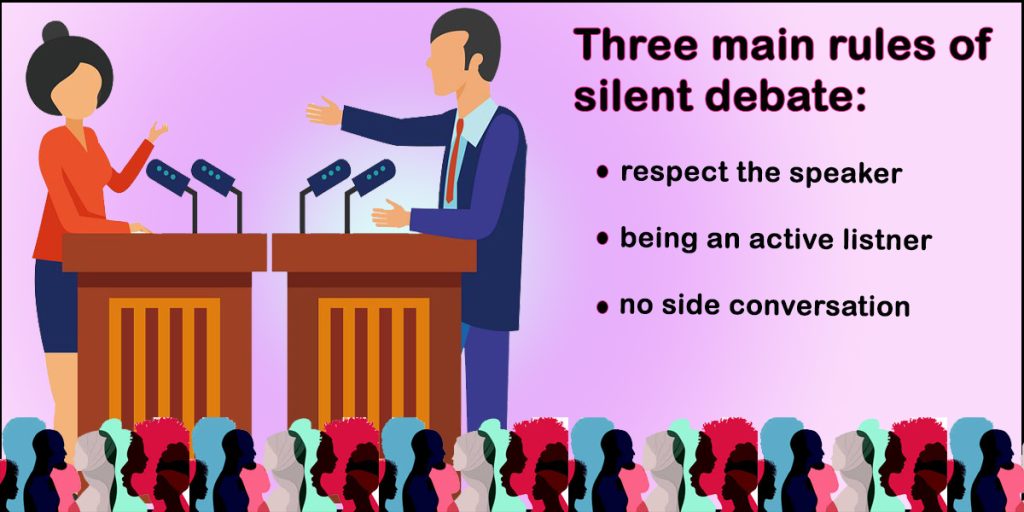Silent debates is a wonderful way to have productive, thoughtful discussions without interruption. To make sure that all participants have an equal opportunity to share their thoughts and ideas, there are some rules and guidelines that should be followed. In this blog post, we will discuss the basics of Silent Debate, including how to participate and what to do if you encounter a problem.
When engaging in silent debate, there are a few ground rules that should be followed to ensure a respectful and productive discussion. Primarily, all participants must be willing to listen to other perspectives without interruption. Secondly, everyone is encouraged to share their thoughts and ideas, but no one is obligated to do so. Lastly, all opinions must be respected regardless of whether they align with your own. following these guidelines will allow for a more positive and constructive debate experience for all involved.
What ss Silent Debates and Why Is It Important
Silent debates are becoming increasingly popular as an engaging and inclusive way to discuss meaningful topics between students, teachers, or other individuals. It take place without speaking; rather, participants can only communicate by writing and using symbols or visuals to make their points. Silent debates are a great way to encourage people of all backgrounds to share their perspectives on a certain topic in a safe environment. However, it is essential to understand and follow the rules for silent debate in order for them to be effective. Ground rules should be established prior to the debate and need to include elements such as respecting others’ opinions, refraining from negative language, maintaining a civil tone of voice, and more. When everybody understands and follows the guidelines of a silent debate, everyone will be able to engage in thoughtful conversations while increasing knowledge on the debated subject matter.
Rules and Guidelines for Silent Debate
When engaging in silent debate, there are a few ground rules that should be followed to ensure a respectful and productive discussion. First, all participants must be willing to listen to other perspectives without interruption. Secondly, everyone is encouraged to share their thoughts and ideas, but no one is obligated to do so. Lastly, all opinions must be respected regardless of whether they align with your own. following these guidelines will allow for a more positive and constructive debate experience for all involved.
The Three Main Rules of Silent
Silent debates offer a powerful way to learn key debating skills and understand perspectives in today’s increasingly diverse social landscape. Silent debates rely on three cardinal rules; respect the speaker, be an active listener, and have no side conversations. By refraining from speech, participants are forced to truly consider the topics discussed. Respect for the speaker requires listeners to give adequate time for the other person to finish their point of view without interruption. Being an active listener entails turning out distractions and actively engaging with arguments presented by focusing on their meaning. Finally, no side conversations ensure that each participant avoids serving as a distraction from another’s point during the debate. Silent debate is an effective tool that helps us not only grow in our critical thinking skills but also teaches us about forming healthy discussion habits.

How To Be an Effective Debater in A Silent Debate
Silent debates are a terrific way to deepen your understanding of a topic and brush up on your debating skills. Being prepared and knowing your material is key to success in this type of environment. To be an effective debater, begin by researching the topic at hand thoroughly and gathering any necessary facts or resources that may be required for you to present your side. Additionally, formulating counterarguments can also help give you clarity heading into the silent debate while allowing you to consider both sides of the issue and craft an argument full of nuance. Best of all, practicing what you have gathered aloud will prepare you for articulating your thoughts clearly once the time comes to present them in a silent debate.
The Benefits of Silent Debate.
Silent debates are a fantastic way to engage your critical thinking and sharpen your communication skills. Not only do Silent Debates require you to think quickly and carefully about how to best articulate an argument in a limited amount of time, but they also allow for a greater focus on the subject being argued about. Silent Debates allow participants to listen actively and pay attention as others present their views, rather than obsessing over what will be said next. Silent Debates also develop active listening skills more naturally since the participants are unable to talk while someone else is speaking. Additionally, Silent Debates boost confidence since the lack of direct criticism gives ample opportunity to practice constructing arguments without the fear of criticism or ridicule. Finally, Silent Debates improve communication skills by encouraging individuals to make sure their ideas are clear and concise before verbalizing them. Overall, Silent Debates can have great benefits for both interpersonal communication and concentration.
What have we Learned
Silent debates can be a great tool to use to sharpen communication and team-building skills. It has the potential to bring people together, despite differing opinions and creative ideas. By following the rules of silent debate, participants are sure to have an enjoyable and educational experience. Silence does not mean anyone is listening; rather, it can produce engaged listeners who gain respect for different perspectives. Silent debate serves as a reminder that we can all learn from each other by simply listening intently and allowing voices unheard before to be heard in a respectful manner. So, take up the challenge of hosting or participating in a silent debate today and begin on the path to effective communication!




